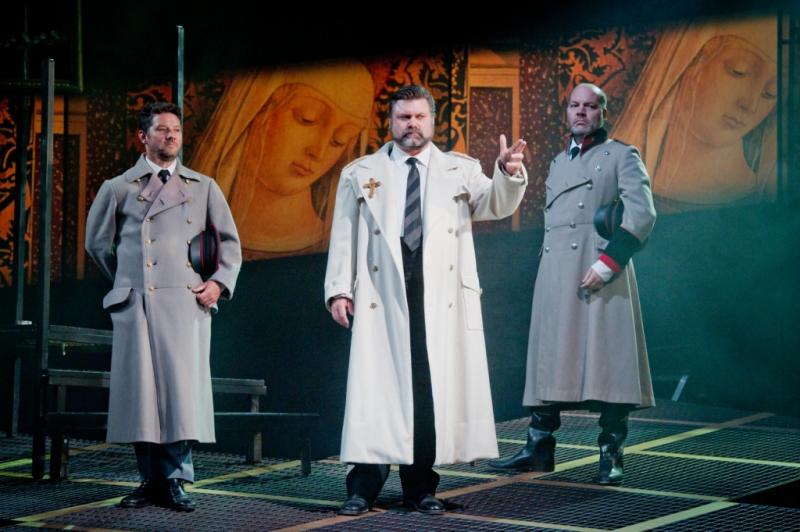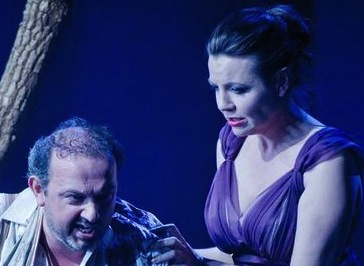Tosca, Longborough Festival | reviews, news & interviews
Tosca, Longborough Festival
Tosca, Longborough Festival
Puccini in a Gloucestershire barn impresses despite first night tremors

For Longborough to open their new season with Tosca after last summer’s triumphant Wagner is to invoke Joseph Kerman’s famous diatribe against Puccini’s “shabby little shocker” in his fifties book Opera as Drama. Kerman used Wagner’s theories to pick holes in Puccini’s at times flagrant theatricality: which only goes to show what an untheoretical thing opera can be.
Not that Richard Studer’s production was without its first night problems. There were shaky moments in the opening scene in Sant’Andrea, not helped by a perilous-looking floor in the form of a heavily raked grill, and updated costumes that presented Tosca and Cavaradossi as a pair of shapeless forty-somethings. Puccini, interestingly, survives reduced orchestration less well than Wagner, perhaps because there is less to spare. And certainly Tosca can’t be doing with a chorus of seven or eight in the offstage cantata of Act 2, or with a children’s choir of ten in the first act, nicely though they may (and do) sing. This is music that needs a quality of attack to go with its heady dramatic aura of brutal and unrestrained violence. It’s the operatic reverse of a limp handshake.
It’s to Studer’s credit, though, that the production weathers these troubles, perhaps not entirely in the first act, but emphatically in the second, as rivetingly directed and sung as I can remember. Well, it’s also musically the strongest act and the fastest moving. Studer, who is his own designer, gets the Palazzo Farnese atmosphere – that characteristic blend of the bon vivant and the psychopath that links Scarpia to Mussolini – with the simplest means: no clutter, no interfering concepts. In the first act a few columns and a crucifix locate us in church; in the third, a single dead tree reminds us, perversely, that Cavaradossi will not hang but will, nevertheless, perish. This is exemplary stage management, which spreads also to the cast, making them the centre of attention and ensuring that the drama is conveyed through their singing and acting.
 They don’t betray this trust. Lee Bisset (pictured right with Adriano Graziani) may not have the vocal grandeur of the greatest Toscas, but she uses what she has with real brilliance, and with a musical intelligence that is reflected in her facial as much as in her vocal expression. She is, to the life, the frail female driven to heroism by a potent mixture of passion and piety. Opposite her, Adriano Graziani is a stylish, alert Cavaradossi, trying hard to look like an artist (in shirt and braces) rather than an Italian tenor, still slightly underpowered in his “Vittoria”, but touching and eloquent elsewhere.
They don’t betray this trust. Lee Bisset (pictured right with Adriano Graziani) may not have the vocal grandeur of the greatest Toscas, but she uses what she has with real brilliance, and with a musical intelligence that is reflected in her facial as much as in her vocal expression. She is, to the life, the frail female driven to heroism by a potent mixture of passion and piety. Opposite her, Adriano Graziani is a stylish, alert Cavaradossi, trying hard to look like an artist (in shirt and braces) rather than an Italian tenor, still slightly underpowered in his “Vittoria”, but touching and eloquent elsewhere.
Simon Thorpe is a youngish Scarpia, perhaps too prone to outbursts of sexual frustration for a successful police chief, but forceful of voice and presence. His minor victims, the agent Spoletta (Richard Roberts), and the escaped political, Angelotti (Nicolas Legoux), tremble before him – as Tosca puts it over his corpse – very convincingly. Wyn Pencarreg is a nice, bumbling Sacristan, the work’s sole representative of the common man, and musically important too in his duet-asides with Cavaradossi.
Jonathan Lyness, whom I heard two weeks ago conducting an excellent chamber Don Pasquale in a Herefordshire barn (for Opera Projects), switches easily to this bigger canvas. This is a Tosca as dramatic as it must be and as well-scaled. It only needs a touch more warmth and precision at exposed moments to clinch a notable production.
The future of Arts Journalism
You can stop theartsdesk.com closing!
We urgently need financing to survive. Our fundraising drive has thus far raised £49,000 but we need to reach £100,000 or we will be forced to close. Please contribute here: https://gofund.me/c3f6033d
And if you can forward this information to anyone who might assist, we’d be grateful.

Subscribe to theartsdesk.com
Thank you for continuing to read our work on theartsdesk.com. For unlimited access to every article in its entirety, including our archive of more than 15,000 pieces, we're asking for £5 per month or £40 per year. We feel it's a very good deal, and hope you do too.
To take a subscription now simply click here.
And if you're looking for that extra gift for a friend or family member, why not treat them to a theartsdesk.com gift subscription?
more Opera
 Albert Herring, English National Opera review - a great comedy with depths fully realised
Britten’s delight was never made for the Coliseum, but it works on its first outing there
Albert Herring, English National Opera review - a great comedy with depths fully realised
Britten’s delight was never made for the Coliseum, but it works on its first outing there
 Carmen, English National Opera review - not quite dangerous
Hopes for Niamh O’Sullivan only partly fulfilled, though much good singing throughout
Carmen, English National Opera review - not quite dangerous
Hopes for Niamh O’Sullivan only partly fulfilled, though much good singing throughout
 Giustino, Linbury Theatre review - a stylish account of a slight opera
Gods, mortals and monsters do battle in Handel's charming drama
Giustino, Linbury Theatre review - a stylish account of a slight opera
Gods, mortals and monsters do battle in Handel's charming drama
 Susanna, Opera North review - hybrid staging of a Handel oratorio
Dance and signing complement outstanding singing in a story of virtue rewarded
Susanna, Opera North review - hybrid staging of a Handel oratorio
Dance and signing complement outstanding singing in a story of virtue rewarded
 Ariodante, Opéra Garnier, Paris review - a blast of Baroque beauty
A near-perfect night at the opera
Ariodante, Opéra Garnier, Paris review - a blast of Baroque beauty
A near-perfect night at the opera
 Cinderella/La Cenerentola, English National Opera review - the truth behind the tinsel
Appealing performances cut through hyperactive stagecraft
Cinderella/La Cenerentola, English National Opera review - the truth behind the tinsel
Appealing performances cut through hyperactive stagecraft
 Tosca, Royal Opera review - Ailyn Pérez steps in as the most vivid of divas
Jakub Hrůša’s multicoloured Puccini last night found a soprano to match
Tosca, Royal Opera review - Ailyn Pérez steps in as the most vivid of divas
Jakub Hrůša’s multicoloured Puccini last night found a soprano to match
 Tosca, Welsh National Opera review - a great company reduced to brilliance
The old warhorse made special by the basics
Tosca, Welsh National Opera review - a great company reduced to brilliance
The old warhorse made special by the basics
 BBC Proms: The Marriage of Figaro, Glyndebourne Festival review - merriment and menace
Strong Proms transfer for a robust and affecting show
BBC Proms: The Marriage of Figaro, Glyndebourne Festival review - merriment and menace
Strong Proms transfer for a robust and affecting show
 BBC Proms: Suor Angelica, LSO, Pappano review - earthly passion, heavenly grief
A Sister to remember blesses Puccini's convent tragedy
BBC Proms: Suor Angelica, LSO, Pappano review - earthly passion, heavenly grief
A Sister to remember blesses Puccini's convent tragedy
 Orpheus and Eurydice, Opera Queensland/SCO, Edinburgh International Festival 2025 review - dazzling, but distracting
Eye-popping acrobatics don’t always assist in Gluck’s quest for operatic truth
Orpheus and Eurydice, Opera Queensland/SCO, Edinburgh International Festival 2025 review - dazzling, but distracting
Eye-popping acrobatics don’t always assist in Gluck’s quest for operatic truth
 MARS, Irish National Opera review - silly space oddity with fun stretches
Cast, orchestra and production give Jennifer Walshe’s bold collage their all
MARS, Irish National Opera review - silly space oddity with fun stretches
Cast, orchestra and production give Jennifer Walshe’s bold collage their all

Add comment